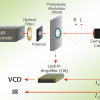Articles
Knowledge of the absolute configuration of asymmetric, chiral carbon atoms is essential for the understanding of enzyme mechanisms, drug action and structure–function relations, as well as for the determination of biological structure. For example, the right-handed alpha helix in proteins and DNA (both right-handed B and left-handed Z) are all based on the knowledge of the absolute configuration of their building blocks, amino acids and nucleic acids, respectively. Knowledge of the absolute configuration is crucial in the discovery, development and the registration of drugs. The independent determination of the absolute configuration is commonly achieved by single crystal X-ray analysis making use of anomalous dispersion. However, crystals of suitable quality are required for this technique. Moreover, the crystal should preferably contain a heavy atom, such as chlorine or heavier, for the anomalous dispersion technique to work. In this article we describe a technique for determining absolute configurations in solution.


